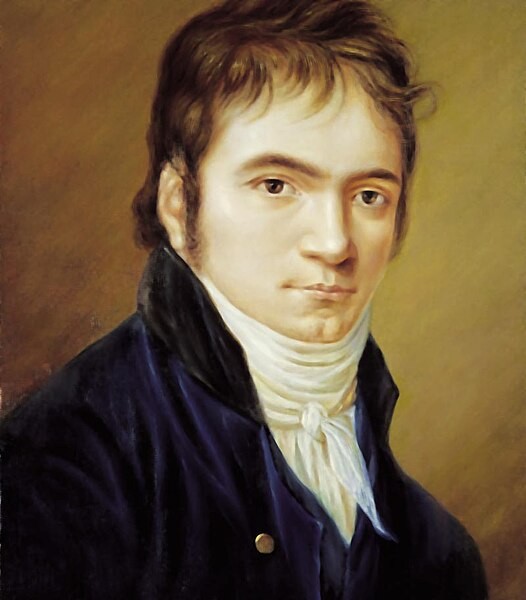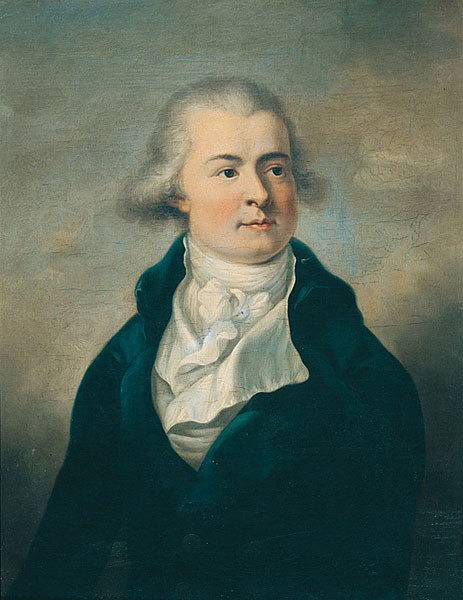A wonderful phrase about the Ysaÿe Quartet is that they have a unity that never becomes uniformity. Unity of expression is sought, but never at the price of homogeneity of sound. In this recording of all of Beethoven’s string quartets, the Ysaÿe takes us through Beethoven’s whole life via one genre.
The recording opens with his Op. 18 quartets, composed between 1798 and 1800 on commission for Prince Franz Maximillan Lobkowitz; they are dedicated to him as well. These 6 quartets, which were published out of compositional order (3, 1, 2, 5, 6, 4). In them, he took the string quartet as it had been handed down by Haydn and Mozart and made it his own. Op. 18/1 gave some the idea of the parting of two lovers, or, as Beethoven himself said, the burial vault scene from Shakespeare’s Romeo and Juliet.

Christian Honeman: Ludwig van Beethoven, 1803 (Beethovenhaus Bonn)

August Friedrich Oelenhainz: Prince Lobkowitz,1816 (The Princely Collections, Lobkowicz Palace, Prague Castle)
Opus 18/2 was noted for its graceful formality. Accordingly, it was given the nickname of the Komplimentierquartett or Compliment Quartet.
Opus 18/4 is where Beethoven starts to play with the second movement. No longer just a slow movement, it has become a combination of a slow movement and a scherzo. The third movement is still a traditional minuet with its contrasting trio.
The other Op. 18 quartets show similar innovation, such as the Op. 18/5 Andante, which has a set of variations where the instruments enter in ascending order, and Op. 18/6, which has a first subject that is a dialogue between the first violin and the cello. The minuet and trio have been replaced by the scherzo and trio.
Six years later, Beethoven returned to the string quartet, first with his 3 Razumovsky quartets, Op. 59 (nos. 7–9), and then the Op 74 (no. 10) and Op. 95 (no. 11). These middle-period quartets form Beethoven’s adherence to classicism with a heroic tone and a ‘display of strength’. The Razumovsky No. 1 has a flowing cello line that has a deceptively limpid flow. It’s only in consulting Beethoven’s sketchbooks that his pain in creating the melody shows through, with more than 100 melodic and rhythmic modifications of this melody alone.
The third Razumovsky quartet, in C major, seems at first to be a return to convention, with a return of the minuet as the dance movement. However, from the very first note, the dissonant opening tells us immediately that we’re not in a regular classical world. The slow introduction takes a bit of time to get us to the main Allegro theme in C major.
After these middle-period works, Beethoven took another 14 years to return to the string quartet. In the last years of his life, the string quartet was his genre of choice, beginning a new quartet while he was still finishing the old one. Invention and imagination shine from every page, and for the final quartets, it took some years for public taste to match what Beethoven had been leading them to. Beethoven moves us from quartets of public appeal to quartets that are rewarded by their own introspection. His complete deafness at the end of his life was part of this mode, but it was also concerned with his own mortality and his look towards the future.

The Quatuor Ysaÿe
The Quatuor Ysaÿe (Guillaume Sutre and Luc-Marie Aguera, violins; Miguel da Silva, viola; and Yovan Markovitch, cello) was formed in 1974 by students at the Paris Conservatoire; it disbanded in 2014. This recording preserves 12 live concerts done in Paris in 2008. This is the Ysaÿe Quartet at the peak of its powers, conquering what is considered the ‘uncompromising musical Everest’ of the complete Beethoven string quartets.

Beethoven: The Complete String Quartets
Quatuor Ysaÿe
La Dolce Volta, LDC600.6 (7 CDs)
Release date: 1 November 2024
Official Website
For more of the best in classical music, sign up for our E-Newsletter

